SÃO PAULO — “Brazil is back,” President-elect Luiz Inácio Lula da Silva told a roaring crowd at the climate summit COP27 in Egypt in November last year.
Indeed, during his first few months in office, Lula met or spoke to numerous leaders from across the world and announced intercontinental trips for practically every upcoming month, signaling that he would seek to significantly increase Brazil’s diplomatic footprint and re-engage on a host of issues ranging from the fight against deforestation and climate change to strengthening multilateralism and weighing in — at times controversially — on the war in Ukraine. Brazil’s rediscovered global activism goes beyond presidential diplomacy. Cabinet members are zigzagging the globe, seeking to present the new Brazil. Environment Minister Marina Silva has readily embraced climate diplomacy, spoke at the World Economic Forum in Davos and recently met U.S. climate envoy John Kerry, while Foreign Minister Mauro Vieira carried the message that Brazil sought to play a greater role at the recent Munich Security Conference and the Raisina Dialogue in Delhi.
Yet the question remains: What does Lula’s return really mean for Latin America and questions like regional trade integration, the region’s relationships with the United States and China, investment flows, and Latin America’s overall role in…









